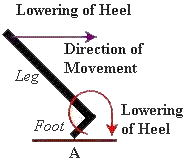
Email : [email protected] Or General Mailer
 |
Jai Chavan's
"Dance-Sport" Email : [email protected] Or General Mailer |
| Back || Master Pg. || Overview || Contents || Alphabetical Index || Home || Next |
Pulling-Back Effect
 |
To keep the speed of movement in the "direction of movement", more or less steady, the turning about point 'A' as shown in red, to rest the angle/corner on the floor needs to be controlled. |
Imagine the leg to be like the angle shown in black that is
very rigid. When moving backward toes touch the floor first when
taking weight of the body on to that foot. Thus the toes touch
the ground at position 'A' in the picture. But the comfortable
position is when the heel is on the floor, which is the corner of
the angle. If the angle is lowered fast then the upper part of
the angle will move much faster. To make the upper part, hence
the body or self move at a steady speed the lowering of the heel
need to be controlled. Thus the body weight is carried on the
ball of the back foot with the heel remaining up. And to
facilitate the body to move back the knees are bent gradually and
the heel of the supporting foot is only lowered when both the
feet are almost together.
The pulling-back effect is when the one moving back suddenly
tends to move further back and away from the partner moving
forward. This is due to the person moving backward allowing the
lowering of the heel fast, which will pull the rest of the body
back.
| Back || Master Pg. || Overview || Contents || Alphabetical Index || Home || Next |